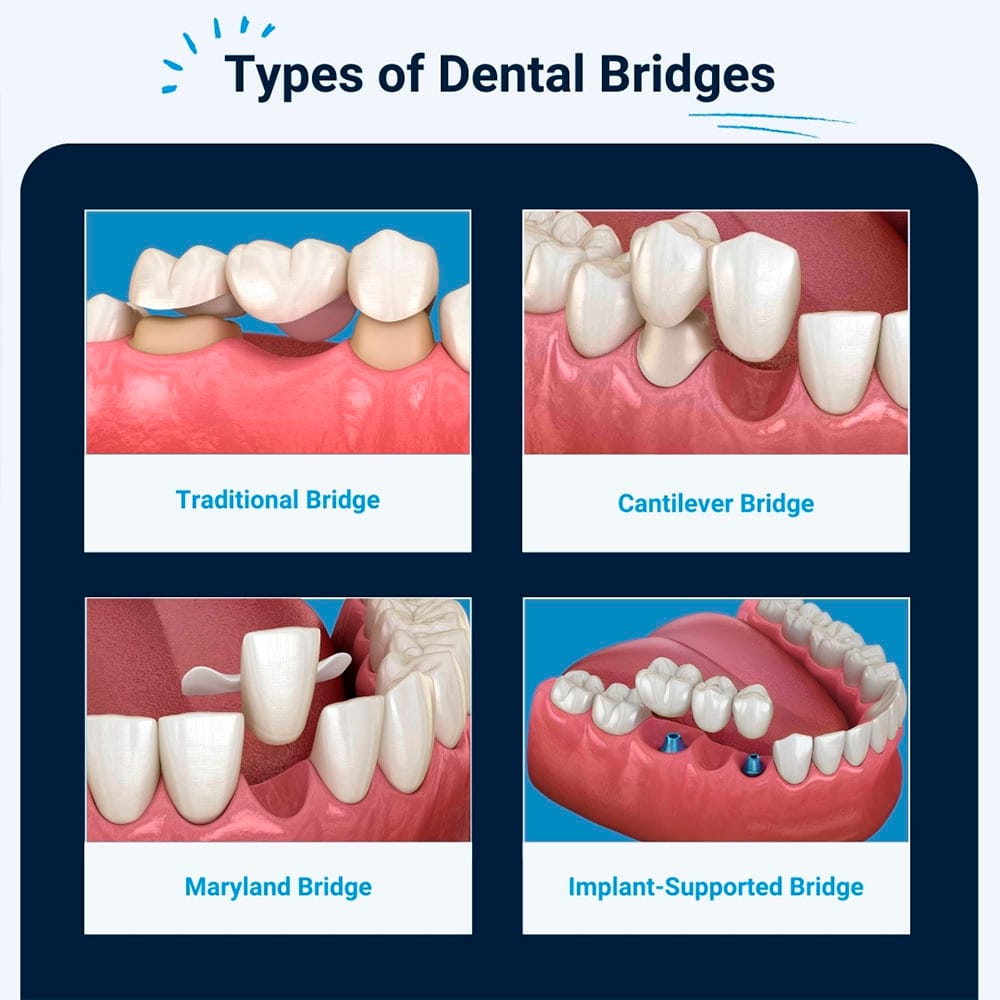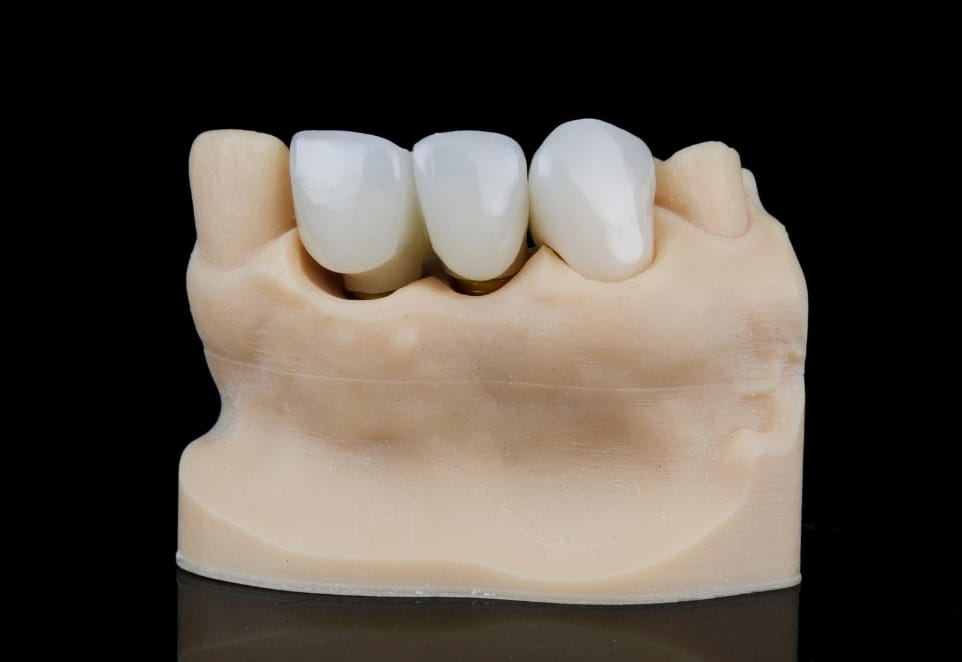What Is a Dental Bridge?
A dental bridge is a dental appliance that replaces one tooth or several missing teeth that were originally side by side. The replacement teeth are supported by dental crowns fitted over your natural teeth, called abutment teeth.
Each replacement tooth is called a pontic and is shaped to rest directly on the gum underneath. The pontic is attached to the crowns, resulting in a restoration that looks natural and functions similarly to real teeth.
Dental bridges can also be used to restore dental implants. An implant bridge can be a good solution if no natural teeth are present to support a traditional bridge.

What Are the Different Types of Dental Bridges?
The dental bridges available can include the following:
- Traditional bridge
- Cantilever bridge
- Maryland bridge
- Implant-supported bridge

Traditional Dental Bridge
A traditional dental bridge is stable and strong, using abutment teeth on either side of the gap, which are covered by crowns. The pontic is attached between these crowns, and the bridge is cemented onto the abutment teeth.
This bridge is ideal when you have healthy teeth on either side of the gap, which can support the pontic between them.
Cantilever Bridge
We may suggest you have a cantilever bridge if abutment teeth that are strong enough to support a bridge are only present on one side of the gap. The pontic is cantilevered off the crown, so it only has support from one side.
A cantilever bridge is weaker than a traditional dental bridge, so it is only suitable in certain circumstances. For example, we may suggest using this type of bridge when replacing front teeth, but it might not be strong enough to support back teeth subjected to substantial chewing forces.
Maryland Bridge
A Maryland bridge doesn’t use crowns for support. Instead, it has wings made from metal or ceramic, which are cemented onto the inner surfaces of the abutment teeth. These support the bridge tooth between them. A Maryland bridge would normally be a single-tooth bridge due to its relatively weak structure.
These bridges generally replace front teeth, especially smaller lower front teeth. A Maryland bridge cannot replace back teeth as it isn’t strong enough.
Because the wings are only bonded in place, they can occasionally pop off. If you have a Maryland bridge and this occurs, please save the bridge and bring it with you to your appointment. We may be able to clean the wings and recement it in place.
Implant Supported Bridge
Dental bridges can be used to restore dental implants. An implant is a small screw or post surgically inserted into your jawbone, and a special abutment is attached to the screw. We then fabricate implant crowns to fit over the abutment and which can support the pontic between them.
An implant bridge can be a good solution if no natural teeth are present to support a traditional bridge.
The type of bridge we recommend will depend on several factors, including:
- The number of teeth missing
- The size of the gap
- The health of the abutment teeth
What Are the Benefits of Choosing a Dental Bridge?
A dental bridge can be a great option for replacing missing teeth because it is relatively quick to make and fit, except for an implant-supported bridge, which takes longer. Other benefits can include:
- Restore biting and chewing function
- Restoring your ability to speak clearly
- Protecting your remaining teeth by preventing them from shifting out of place
- Restoring your facial appearance
Every bridge we make is custom-designed to look and feel natural, and we use the latest ceramics that closely replicate the appearance of real teeth. It should restore your ability to bite and chew food comfortably, providing excellent functionality.
Are There Any Disadvantages in Choosing a Dental Bridge?
Choosing this restorative dental treatment has a few disadvantages, as we must remove some tooth structure when preparing abutment teeth for crowns.
Removing potentially healthy tooth structure can increase the risk of these abutment teeth becoming decayed and infected later. Also, if your abutment teeth are weaker, there is a risk they could fracture due to the increased stress and strain.
What Can Dental Bridges Be Made of?
Various materials can be used to fabricate your dental bridge. These include:
- Metal alloy
- Porcelain fused to metal (PFM)
- All ceramic
Metal Alloy
It would be rare for us to make a bridge entirely from metal alloy because it would be highly visible in the mouth. However, it is an option, and the metal alloy can be gold or silver-colored and highly polished.
Porcelain Fused to Metal (PFM)
This type of bridge has a thin substructure made from metal alloy covered with porcelain. The result is a reasonably natural-looking dental bridge, but the porcelain can look opaque due to the metal underneath. A PFM bridge can be a good option when restoring back teeth, but there is a risk that it could chip or crack over time.
All Ceramic
These modern bridges are entirely metal-free and can be made from a pressable ceramic material or zirconia.
Pressable Dental Bridges
Pressable ceramic bridges are formed by melting a ceramic material and pressing it under vacuum. Additional porcelain is then added to create a beautiful and aesthetically pleasing bridge. This type of bridge is excellent when restoring front teeth, but it is only usually recommended for a three-tooth or three-unit bridge.
Zirconia Dental Bridges
Zirconia is much stronger; we can create beautiful bridges that replace multiple teeth. It is even possible to fabricate a bridge replacing a complete arch of teeth with zirconia. This material is extremely strong yet natural-looking. Additional porcelain can be added to a zirconia bridge to create a beautiful and lifelike restoration.
What Is the Procedure for Making and Fitting a Bridge?
You will most likely need several appointments for us to make and fit your bridge. Initially, you will need a consultation so we can determine which type of bridge will suit you best and provide an optimal treatment outcome.
The process depends on the type of bridge selected.
Making and Fitting Traditional and Cantilever Bridges
- After numbing your teeth, our dentist will reshape them before taking a digital dental impression. The digital file of your impression is securely transmitted to our dental lab, along with our exact prescription. It will normally take two weeks to make.
- A temporary bridge will protect your teeth while your permanent bridge is being fabricated. This bridge will be more fragile, so you may need to avoid eating anything very hard, crunchy, or sticky that could damage it.
- On your second visit, we remove your temporary bridge so we can try in and check the fit of your permanent bridge. It is cemented onto your teeth, and we will make any final adjustments to ensure it looks and feels perfect.
Making and Fitting a Maryland Bridge
- Preparing the abutment teeth for the Maryland bridge wings wouldn’t normally be necessary, so we will take a digital dental impression during your initial visit. This will be sent to our dental lab so your Maryland bridge can be made to our prescription.
- On your second visit, we will prepare the abutment teeth by etching the surfaces lightly to increase the bond between the bridge and your teeth.
- We will try in your Maryland bridge and can cement it in place.
Making and Fitting an Implant Supported Bridge
The process of making and fitting an implant-supported bridge is much more complex. You can find detailed information about this procedure in our dental implant section.
How to Look After Your Bridge
Once your bridge is in place, we can give you detailed instructions on how to properly care for it. In addition to brushing and flossing the bridge, it is essential to clean underneath the pontics thoroughly.
We can show you how to do this and discuss the best tools. These might be a floss threader, interdental brushes, or a WaterPik. Finding a method that will be easy for you to use is important so you can do this daily.
We recommend regular appointments with our excellent hygiene team at Clock Tower Dental. Professionally cleaning your bridge regularly will help prolong its life.
How Long Should a Dental Bridge Last?
Usually, a dental bridge will last 10 years or more, but that depends on your oral habits. The better you care for your bridge, the longer it should last and be problem-free. We can check its condition at every dental exam because, eventually, it will need replacing.
Can I Claim the Cost of My Dental Bridge under My Insurance?
You can most likely claim at least part of the cost of your dental bridge because this is a restorative dental treatment. The percentage covered may depend on the type of bridge chosen and your dental plan. We can discuss how much of the cost might be covered during your consultation.
Learn Which Bridge Might Suit You Best
If you want to learn more about teeth bridges and how they could restore your dental health and smile, contact us to schedule your consultation.

